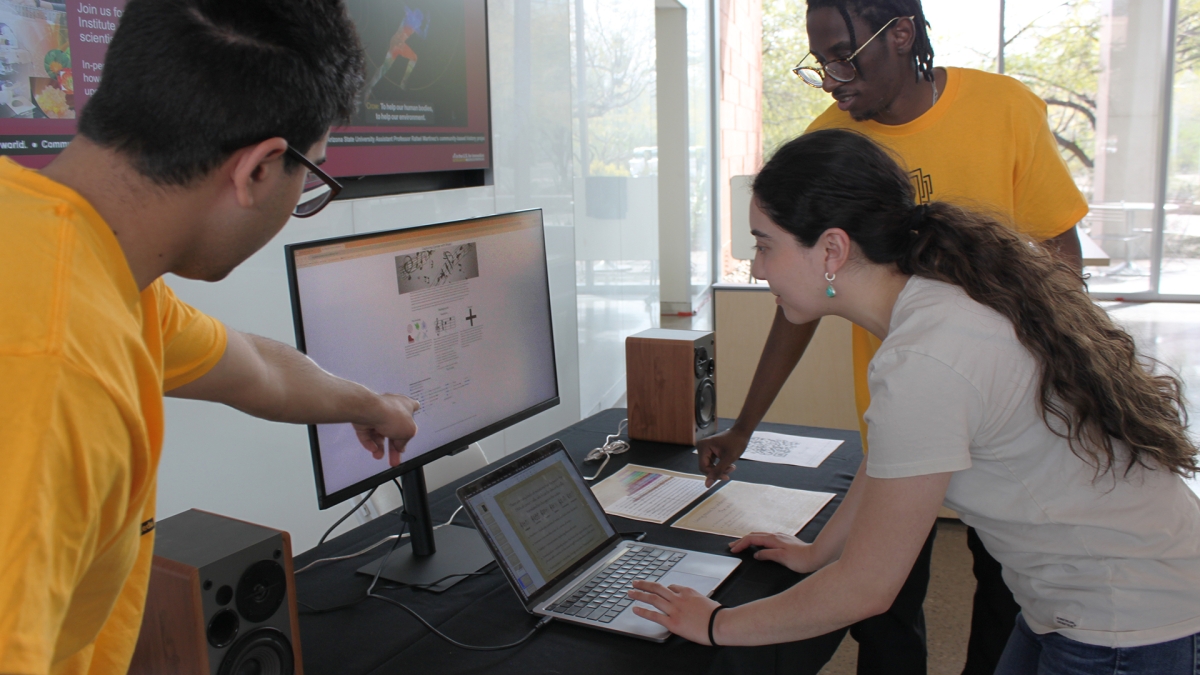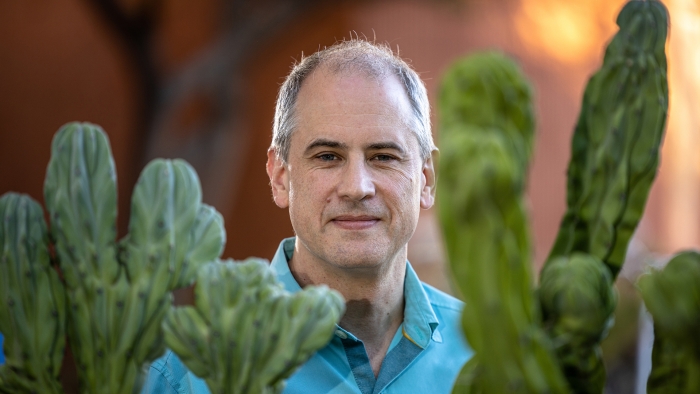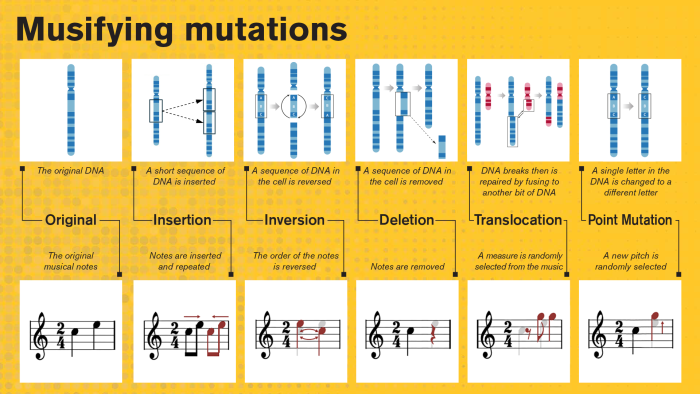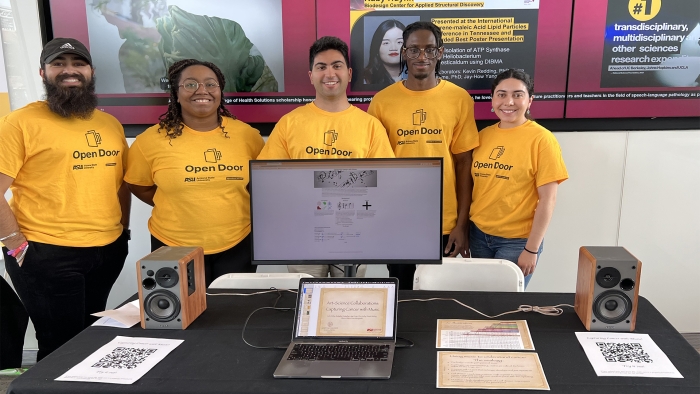Improved cancer literacy is music to researchers’ ears

Student volunteers demonstrate software that captures cancer as music at the ASU Open Door event. Photo by Kelly deVos/ASU
When it comes to cancer, Carlo Maley is out to treat it and beat it.
Maley is a biologist, the director of the Arizona Cancer Evolution Center and a professor in Arizona State University’s School of Life Sciences. He primarily studies three things: how normal tissue evolves into cancers, why some cancers become resistant to treatment and why some animals, like elephants and whales, are better at suppressing cancer than humans.
But because advocating for cancer patients is an important aspect of Maley’s work, he also examines how to improve cancer literacy.
“When you’re diagnosed with cancer, it’s such an existential crisis,” he says. “It becomes very hard for patients to digest and really understand the big stack of information that gets handed to them.”
Efforts to help the public understand cancer are an important part of the work being done to ensure better health care outcomes. People with good cancer literacy might, for example, elect to quit smoking, stay active and get appropriate early screening tests from their doctors.
Always on the lookout for better ways to explain the evolution of cancer, Maley has done a series of collaborations with artists, including the Biodesign cactus garden.
“For me, the problem has been that graphical arts, like paintings, tend to be static. But cancer is an evolving system,” Maley says, noting that cancer cells mutate, divide, die and change in response to therapy.
Maley recently came to a pair of student researchers at the School of Computing and Augmented Intelligence, part of the Ira. A Fulton Schools of Engineering at ASU, with a novel project.
“I was trying to think of what medium of art could capture that kind of dynamic through time,” Maley says. “And it struck me that music is one of those media.”
Jiayi Hong, a postdoctoral research scholar, and Rostyslav Hnatyshyn, a computer science graduate student, who conduct research in the Center for Accelerating Operational Efficiency, worked with Maley to create a piece of software that uses music as a metaphor to express cancer through a process known as musification.
Musification is a method of converting data into music. It differs from sonification — the process of converting data into sound. Many people are familiar with the Geiger counter, a device frequently shown in films, that detects radiation and then uses sonification to emit popping sounds to alert the user to danger. But with musification, the data must be able to be heard and perceived as music and not just as a series of noises.
As part of the project, Hong and Hnatyshyn studied other digital approaches to improve cancer literacy. They looked at video games and found a research group that produced a Spanish-language soap opera designed to improve health care outcomes for Hispanic women. While these projects were perceived as effective, they were not helpful to people with visual impairments or poor fine motor skills.
Twinkle, twinkle littel tsar
Next, the research students worked with Maley to understand how cancer affects the body. Human cells each contain an individual’s genetic material, or DNA. Healthy cells reproduce by copying that DNA over and over into new cells. When a cell becomes cancerous, the DNA mutates in unhealthy ways. The cancerous cells begin replicating, and the body struggles to control the growth.
Under Maley’s guidance, the team represented five types of mutations in the sequence of DNA — insertion, deletion, inversion, translocation and point mutations — by making changes to the sequence of notes in the music. Hong and Hnatyshyn wrote software that can take well-known pieces of music, like the lullaby “Twinkle, Twinkle, Little Star” and the song “Happy Birthday,” and apply those mutations to the music to simulate how cancer cells mutate.
They turned to Chris Norby, an instructor in the ASU School of Music, Dance and Theatre, to better understand how they might "musify" the cancerous mutations.
Norby, a composer whose commissioned concert works have been performed at major venues such as the Royal Festival Hall and the National Gallery of Ireland, says, “We discussed specific mathematical composition techniques and how these could be adapted to highlight cancerous mutations in a tangible way.”
In the beginning, the software represents the healthy cells as the song’s original musical notes. In a piece of music with multiple parts (such as violins, cellos and flutes), one is designated to start the cancerous process. Instead of continuing its melody, that part starts repeating the last phrase it played and its notes are copied into a new part, but with mutations.
The result is a song that sounds familiar but goes sour over time. Finally, when the cancerous cells are subjected to a successful treatment, the cancer parts are silenced. This illustrates the death of the cancer cells, leaving behind the healthy cells in the form of the original melody.
Written in the programming language Python, the development process was the toughest part of the project for Hnatyshyn.
“There are so many details you need to address to make sure that the code works correctly and that the music, after we’re done mutating, actually still makes sense,” he says.
After completing their software development, the researchers conducted studies to test their work. Subjects said they generally felt that musification is helpful, especially for people who aren’t strong readers or have issues with verbal comprehension.
Norby also says that choosing familiar songs is a key part of the project’s success.
“Using recognizable melodies was an important starting point in terms of relatability to a general public,” he said.
New approach opens new doors
Along with ASU faculty members, Hong and Hnatyshyn co-authored a paper called “Capturing Cancer as Music: Cancer Mechanisms Expressed through Musification,” which was accepted by the Association of Computing Machinery CHI conference on Human Factors in Computing Systems. Hnatyshyn will present it at the conference in Honolulu, Hawaii, in May.
They also showcased the project at ASU’s Open Door, a university-wide series of on-campus events that encourages the Arizona community to see and experience the innovative work being done by student and faculty researchers. Student volunteers set up a computer and demonstrated the musification software to the public at the ASU Tempe campus event in February.
The project also gave Hong and Hnatyshyn a unique opportunity to receive mentorship from faculty members from multiple disciplines.
“Fostering interdisciplinary cooperation is a critical aspect of our work here. Solving large-scale, real-world problems will require the cross-collaborative efforts of experts from many fields,” says Ross Maciejewski, director of the School of Computing and Augmented Intelligence and a technical advisor on the project. “We are building educational systems to prepare students for that future.”
But it was the prospect of using computer science to help others that resonated most with the student researchers.
“During one of our studies, we came across a cancer survivor who had a strong emotional reaction,” Hong says. “She cried after she heard the music. It really impacted her.”
Hnatyshyn adds, “We realized we are doing something profound, something meaningful. That was really nice to see.”
In the future, the team plans to work with oncologists to see if the tool is useful for patients as they struggle to understand the complexities of cancer.
More Science and technology

Hack like you 'meme' it
What do pepperoni pizza, cat memes and an online dojo have in common?It turns out, these are all essential elements of a great cybersecurity hacking competition.And experts at Arizona State…

ASU professor breeds new tomato variety, the 'Desert Dew'
In an era defined by climate volatility and resource scarcity, researchers are developing crops that can survive — and thrive — under pressure.One such innovation is the newly released tomato variety…

Science meets play: ASU researcher makes developmental science hands-on for families
On a Friday morning at the Edna Vihel Arts Center in Tempe, toddlers dip paint brushes into bright colors, decorating paper fish. Nearby, children chase bubbles and move to music, while…




